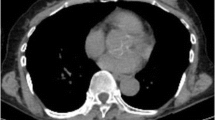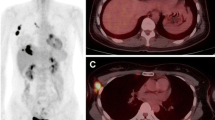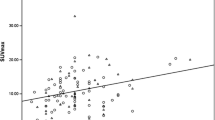Abstract
Purpose
To determine the prognostic implications of pretreatment F-18 FDG PET/CT in patients with invasive ductal breast cancer (IDC), we evaluated the relationship between FDG uptake of the primary tumor and known prognostic parameters of breast cancer. Prognostic significance of tumoral FDG uptake for the prediction of progression-free survival (PFS) was also assessed.
Materials and Methods
Fifty-five female patients with IDC who underwent pretreatment F-18 FDG PET/CT were enrolled. The maximum standardized uptake value of the primary tumor (pSUVmax) was compared with clinicopathological parameters including tumor size, grade, estrogen receptor (ER), progesterone receptor (PR), human epidermal growth factor receptor2 (HER2), axillary lymph node (LN) metastasis, and stage. The prognostic value of pSUVmax for PFS was assessed using the Kaplan-Meier method.
Results
A high pSUVmax was significantly related to a higher stage of tumor size (P < 0.05), grade (P < 0.001), and stage (P < 0.001). pSUVmax was significantly higher in ER-negative tumors (P < 0.001), PR-negative tumors (P < 0.001), and positive LN metastasis (P < 0.01), but not different according to HER2 status. pSUVmax was significantly higher in patients with progression compared to patients who were disease-free (10.6 ± 5.1 vs. 4.7 ± 3.5, P < 0.001). A receiver-operating characteristic curve demonstrated a pSUVmax of 6.6 to be the optimal cutoff for predicting PFS (sensitivity; 86.7%, specificity; 82.5%). The patients with a high pSUVmax (more than 6.6) had significantly shorter PFS compared to patients with a low pSUVmax (P < 0.0001).
Conclusions
pSUVmax on pretreatment F-18 FDG PET/CT could be used as a good surrogate marker for the prediction of progression in patients with IDC.





Similar content being viewed by others
References
Desantis C, Center MM, Siegel R, Jemal A. American Cancer Society. Breast Cancer Facts & Figures 2009–2010 Atlanta: American Cancer Society, Inc. http://www.cancer.org/acs/groups/content/@nho/documents/document/f861009final90809pdf.pdf
Lavayssière R, Cabée AE, Filmont JE. Positron emission tomography (PET) and breast cancer in clinical practice. Eur J Radiol. 2009;69:50–8.
Geus-Oei LF, Oyen WJ. Predictive and prognostic value of FDG-PET. Cancer Imaging. 2008;8:70–80.
Allal AS, Slosman DO, Kebdani T, Allaoua M, LehmannW DP. Prediction of outcome in head-and-neck cancer patients using the standardized uptake value of 2-[18F]fluoro-2-deoxy-D-glucose. Int J Radiat Oncol Biol Phys. 2004;59:1295–300.
Downey RJ, Akhurst T, Gonen M, Vincent A, Bains MS, Larson S, et al. Preoperative F-18 fluorodeoxyglucose-positron emission tomography maximal standardized uptake value predicts survival after lung cancer resection. J Clin Oncol. 2004;22:3255–60.
Sasaki R, Komaki R, Macapinlac H, Erasmus J, Allen P, Forster K, et al. [18F] fluorodeoxyglucose uptake by positron emission tomography predicts outcome of non-small-cell lung cancer. J Clin Oncol. 2005;23:1136–43.
Vansteenkiste JF, Stroobants SG, Dupont PJ, De Leyn PR, Verbeken EK, Deneffe GJ, et al. Prognostic importance of the standardized uptake value on F-18 fluoro-2-deoxy-glucose-positron emission tomography scan in non-small-cell lung cancer: an analysis of 125 cases. Leuven lung cancer group. J Clin Oncol. 1999;10:3201–6.
Nguyen XC, Lee WW, Amin AM, Eo JS, Bang SM, Lee JS, et al. Tumor burden assessed by the maximum standardized uptake value and greatest diameter on FDG-PET predicts prognosis in untreated diffuse large B-cell lymphoma. Nucl Med Mol Imaging. 2010;44:39–44.
Wolff AC, Hammond ME, Schwartz JN, Hagerty KL, Allred DC, Cote RJ, et al. American Society of Clinical Oncology/College of American Pathologists guideline recommendations for human epidermal growth factor receptor 2 testing in breast cancer. Arch Pathol Lab Med. 2007;131:18–43.
Minn H, Zasadny KR, Quint LE, Wahl RL. Lung cancer: reproducibility of quantitative measurements for evaluating 2-[F-18]-fluoro-2-deoxy-D-glucose uptake at PET. Radiology. 1995;196:167–73.
Ikenaga N, Otomo N, Toyofuku A, Ueda Y, Toyoda K, Hayashi T, et al. Standardized uptake values for breast carcinomas assessed by fluorodeoxyglucose-positron emission tomography correlate with prognostic factors. Am Surg. 2007;73:1151–7.
Mavi A, Cermik TF, Urhan M, Puskulcu H, Basu S, Yu JQ, et al. The effects of estrogen, progesterone, and C-erbB-2 receptor states on 18F-FDG uptake of primary breast cancer lesions. J Nucl Med. 2007;48:1266–72.
Gil-Rendo A, Martínez-Regueira F, Zornoza G, García-Velloso MJ, Beorlegui C, Rodriguez-Spiteri N. Association between [18F]fluorodeoxyglucose uptake and prognostic parameters in breast cancer. Br J Surg. 2009;96:166–70.
Oshida M, Uno K, Suzuki M, Nagashima T, Hashimoto H, Yagata H, et al. Predicting the prognoses of breast carcinoma patients with positron emission tomography using 2-deoxy-2-fluoro[18 F]-D-glucose. Cancer. 1998;82:2227–34.
Ueda S, Tsuda H, Asakawa H, Shigekawa T, Fukatsu K, Kondo N, et al. Clinicopathological and prognostic relevance of uptake level using 18F-fluorodeoxyglucose positron emission tomography/computed tomography fusion imaging (18 F-FDG PET/CT) in primary breast cancer. Jpn J Clin Oncol. 2008;38:250–8.
Inoue T, Yutani K, Taguchi T, Tamaki Y, Shiba E, Noguchi S. Preoperative evaluation of prognosis in breast cancer patients by [18F]2-Deoxy-2-fluoro-D-glucose-positron emission tomography. J Cancer Res Clin Oncol. 2004;130:273–8.
Kawamura T, Kusakabe T, Sugino T, Watanabe K, Fukuda T, Nashimoto A, et al. Expression of glucose transporter-1 in human gastric carcinoma: association with tumor aggressiveness, metastasis, and patient survival. Cancer. 2001;92:634–41.
Cerfolio RJ, Bryant AS. Maximum standardized uptake values on positron emission tomography of esophageal cancer predicts stage, tumor biology, and survival. Ann Thorac Surg. 2006;82:391–5.
Minn H, Lapela M, Klemi PJ, Grénman R, Leskinen S, Lindholm P, et al. Prediction of survival with fluorine-18-fluoro-deoxyglucose and PET in head and neck cancer. J Nucl Med. 1997;38:1907–11.
Cerfolio RJ, Bryant AS, Ohja B, Bartolucci AA. The maximum standardized uptake values on positron emission tomography of a non-small cell lung cancer predict stage, recurrence, and survival. J Thorac Cardiovasc Surg. 2005;130:151–9.
Basu S, Chen W, Tchou J, Mavi A, Cermik T, Czerniecki B, et al. Comparison of triple-negative and estrogen receptor-positive/progesterone receptor-positive/HER2-negative breast carcinoma using quantitative fluorine-18 fluorodeoxyglucose/positron emission tomography imaging parameters: a potentially useful method for disease characterization. Cancer. 2008;112:995–1000.
Toikkanen S, Pylkkanen L, Joensuu L. Invasive lobular carcinoma of the breast has better short- and long-term survival than invasive ductal carcinoma. Br J Cancer. 1997;76:1234–40.
Acknowledgment
This work was supported by the Nuclear Research & Development Program of the National Research Foundation of Korea (NRF) funded by Ministry of Education, Science & Technology (MEST) (grant code: 2010–0017515), the Ministry of Knowledge Economy (MKE), Korea Institute for Advancement of Technology (KIAT), and the Daegyeong Leading Industry Office through the Leading Industry Development for the Economic Region, and a grant from the Korean Ministry of Education, Science and Technology (The Regional Core Research Program/Anti-aging and Well-being Research Center)
Author information
Authors and Affiliations
Corresponding author
Rights and permissions
About this article
Cite this article
Song, BI., Hong, C.M., Lee, H.J. et al. Prognostic Value of Primary Tumor Uptake on F-18 FDG PET/CT in Patients with Invasive Ductal Breast Cancer. Nucl Med Mol Imaging 45, 117–124 (2011). https://doi.org/10.1007/s13139-011-0081-0
Received:
Revised:
Accepted:
Published:
Issue Date:
DOI: https://doi.org/10.1007/s13139-011-0081-0




